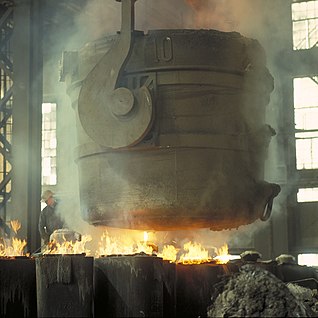Disteel brand pressed-steel automobile wheels were manufactured by the Detroit Pressed Steel Company, and were introduced in 1917 as an alternative to wooden artillery wheels with demountable rims. Pressed steel wheels were an alternative to fragile wooden wheels which would crack on impact with very rough roads. Steel wheels were both stronger and cheaper to manufacture, and could be painted any color the owner desired.

Steel is an alloy of iron and carbon, and sometimes other elements. Because of its high tensile strength and low cost, it is a major component used in buildings, infrastructure, tools, ships, automobiles, machines, appliances, and weapons.

In its primitive form, a wheel is a circular block of a hard and durable material at whose center has been bored a circular hole through which is placed an axle bearing about which the wheel rotates when a moment is applied by gravity or torque to the wheel about its axis, thereby making together one of the six simple machines. When placed vertically under a load-bearing platform or case, the wheel turning on the horizontal axle makes it possible to transport heavy loads; when placed horizontally, the wheel turning on its vertical axle makes it possible to control the spinning motion used to shape materials ; when mounted on a column connected to a rudder or a chassis mounted on other wheels, one can control the direction of a vessel or vehicle ; when connected to a crank, the wheel produces or transmits energy.

The artillery wheel was developed for use on gun carriages when it was found that the lateral forces involved in horse artillery manoeuvres caused normally constructed cart wheels to collapse. Rather than having its spokes mortised into a wooden nave (hub), it has them fitted together (mitred) then bolted into a metal nave. Its tyre is shrunk onto the rim in the usual way but it is also bolted on for security. A normal wagon wheel is dished so that in its lowest part, the spokes are perpendicular to the ground thus supporting the weight. This is not done with artillery wheels.
Disteel wheels were offered as an extra cost option on many vehicles produced at the time, to include Duesenberg, [1] Lincoln, Cole, and Page-Detroit vehicles of the 1920s.

Duesenberg Motors Company was an American manufacturer of race cars and luxury automobiles. It was founded by brothers August and Frederick Duesenberg in 1913 in Saint Paul, Minnesota, where they built engines and race cars. The brothers moved their operations to Elizabeth, New Jersey in 1916 to manufacture engines for World War I. In 1919, when their government contracts were cancelled, they moved to Indianapolis, Indiana, home of the Indianapolis Motor Speedway, and established the Duesenberg Automobile and Motors Company, Inc. (Delaware). In late 1926, E.L. Cord added Duesenberg to his Auburn Automobile Company. With the market for expensive luxury cars severely undercut by the Depression, Duesenberg folded in 1937.

The Cole Motor Car Company was an early automobile maker based in Indianapolis, Indiana. Cole automobiles were built from 1908 until 1925. They were quality-built luxury cars. The make is a pioneer of the V-8 engine.
Paige was a Detroit, United States-based automobile company, selling luxury cars between 1908 and 1927.
In March 1923, the Detroit Pressed Steel Company was merged with both the Parish and Bingham Company of Cleveland, Ohio, and the Parish Manufacturing Company of Detroit, to form a new company, called the Midland Steel Products Company by Elroy J. "E.J." Kulas, after leaving the Peerless Automobile Company. [2]

Detroit is the largest and most populous city in the U.S. state of Michigan, the largest United States city on the United States–Canada border, and the seat of Wayne County. The municipality of Detroit had a 2017 estimated population of 673,104, making it the 23rd-most populous city in the United States. The metropolitan area, known as Metro Detroit, is home to 4.3 million people, making it the second-largest in the Midwest after the Chicago metropolitan area. Regarded as a major cultural center, Detroit is known for its contributions to music and as a repository for art, architecture and design.













